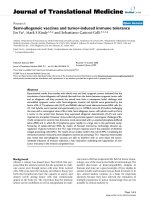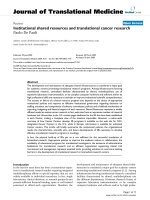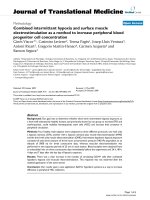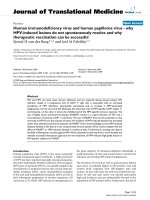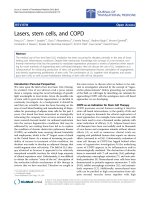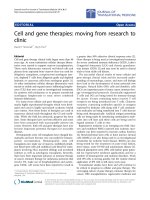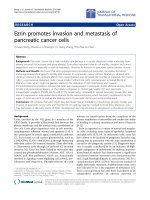Báo cáo hóa học: "Immuno-Oncology Biomarkers 2010 and Beyond: Perspectives from the iSBTc/SITC Biomarker Task Force" pot
Bạn đang xem bản rút gọn của tài liệu. Xem và tải ngay bản đầy đủ của tài liệu tại đây (344.63 KB, 9 trang )
S
ociety
f
or Immunotherapy o
f
C
ance
r
(formerly the International Society for Biological Therapy of Cancer)
Symposium Summary
September 30, 2010 - National Institutes of Health, Bethesda, MD
I
mmuno-Oncology Biomarkers 2010 and Beyond:
Perspectives from the iSBTc/SITC
Biomarker Task Force
Interaction • Innovation • Integration • Exchange • Translation • Leadership
Guidin
g
cancer immunotherap
y
from bench to bedside
Immuno-Oncology biomarkers 2010 and beyond:
Perspectives from the iSBTc/SITC biomarker task
force
Butterfield et al.
Butterfield et al. Journal of Translational Medicine 2010, 8:130
(7 December 2010)
COM M E N T AR Y Open Access
Immuno-Oncology biomarkers 2010 and beyond:
Perspectives from the iSBTc/SITC biomarker
task force
Lisa H Butterfield
1
, Mary L Disis
2
, Samir N Khleif
3
, James M Balwit
4
, Francesco M Marincola
5*
Abstract
The International Society for Biological Therapy of Cancer (iSBTc, recently renamed the Society for Immunotherapy
of Cancer, SITC) hosted a one-day symposium at the National Institutes of Health on September 30, 2010 to
address development and application of biomarkers in cancer immunotherapy. The symposium, titled Immuno-
Oncology Biomarkers 2010 and Beyond: Perspectives from the iSBTc/SITC Biomarker Task Force, gathered approximately
230 investigators equally from academia, industry and governmental/regulatory agencies from around the globe
for panel discussions and presentations on the following topics: 1) immunologic monitoring: standardization and
validation of assays; 2) correlation of immunity to biologic activity, clinical response and potency assays; 3) novel
methodologies for assessing the immune landscape: clinical utility of novel technologies; and 4) recommendations
on incorporation of biomarkers into the clinical arena. The presentations are summarized in this report; additional
program information and slides are available online at the iSBTc/SITC website.
Introduction
Over the l ast decade, cancer therapies that target specific
molecular pathways or specific cell types have moved
from the laboratory into clinical practice. Simila rly, bio-
markers that may indicate suitable patient populations
for these therapies or act as surrogates for the potential
development of a clinical responseareincreasinglyused
in the clinic. The clinical application of biomarkers to
assess the effe ct of immune-based cancer therapies is
important for sever al reasons. First, immune-based treat-
ments, such as vaccines, are often designed to elicit a spe-
cific response so that the measurement of that response
could be a marker of product (e.g., vaccine) potency. Sec-
ondly, as immune-based therapies are tested earlier in
the therapeutic pathway (e.g., in the adjuvant setting),
biomarkers of response become increasingly important as
potential endpoints of clinical trials. Finally, clinically
qualified biomarkers are needed so that new immu-
notherapies can be rapidly and efficiently tested and
translated to clinical practice.
As laboratory-based assays are being transitioned to
clinical assays, several issues are raised. The assays must
be robust. The clinical sa mples collected for analysis
must be processed in a uniform way to ensure reproduci-
bility of results. Results must be reported in a detailed
and uniform way. New assays which have been devel-
oped, that will allow broad analysis of multiple immune
parameters, must now be b etter utilized. The lessons
learned from biomarker studies in fields such as HIV/
AIDS and other infectious diseases, must be better incor-
porated into cancer immunotherapy studies.
To address these and other issues related to the devel-
opm ent and application of biomarkers in cance r immu-
notherapy, the International Society for Biological
Therapy of Cancer (iSBTc, recently renamed the Society
for Immunotherapy of Cancer, SITC) hosted a one-day
symposium at the National Institutes of He alth on
September 30, 2010. The symposium, titled Immuno-
Oncology Biomarkers 2010 and Beyond: Perspectives
from the iSBTc/SITC Biomarker Task Force,wasorga-
nizedbyLisaH.Butterfield, PhD (University of Pitts-
burgh),MaryL.Disis,MD(UniversityofWashington),
Samir N. Khleif, MD (National Cancer Institute, CCR)
and Francesco Marincola, MD (National Institutes of
Health, CC, DTM). This program was a direct extension
* Correspondence:
5
Infectious Disease and Immunogenetics Section (IDIS), Dept. of Translation
Medicine, Clinical Center, and Center for Human Immunology (CHI), National
Institutes of Health, Bethesda, MD, USA
Full list of author information is available at the end of the article
Butterfield et al. Journal of Translational Medicine 2010, 8:130
/>© 2010 Butterfield et al; licensee BioM ed Central Ltd. This is an Open Access article distributed under the terms of the Creative
Commons Attribution License (http://creative commons.org/licenses/by/2.0), which permits unrestricted use, distribut ion, and
reproduction in any medium, provided the original work is properly cit ed.
of the efforts of the iSBTc/SITC Biomarkers Taskforce
[1,2], which recently published a collaborative report of
its 2009 Workshop (iSBT c-FDA-N CI Workshop on Prog-
nostic and Predictive Immunologic Biomarkers in Can-
cer) and the recommendations whic h resulted from the
work of the Taskforce [3].
SITC President Bernard A. Fox, PhD (Earle A. Chiles
Research Institute) initiated the symposium with a pre-
sentation on critical hurdles in cancer immunotherapy
that lead to delays of scientific discoveries which provide
strong evidence of antitumor effects in preclinical models
to be t ested in patients. As an extension from the 2009
iSBTc-FDA-NCI Workshop on Biomarkers, SITC and
collaborating organizations had identified seven critical
hurdles to the effective translation of cancer immu-
notherapy: 1) the inadequacy of animal models as predic-
tors of effi cacy; 2) the prolonged time to obtai n approval
for clinical trials; 3) the complexity of cancer biology/
immunology; 4) the inability to obtain approval to com-
bine most promising new agents in trials; 5) the lack of
definitive biomarker(s) for assessm ent of clinical efficacy;
6) the paucity of translational research teams; and 7) the
insuff icient exchange of information critical to advancing
the field. Fox discussed each of these problems and
stressed the need to intensify collaboration to d efine
potential solution. Accordingly, following the symposium
(October 1, 2010) SITC hosted a Collaboration Summit
with representatives from nine other domest ic and inter-
national associations with similar interests in promoting
research and translation of cancer immunotherapy (see
Appendi x). In an effort spearheaded by Fox, on behalf of
SITC, the collaborating associations are preparing a joint
publication that furth er defines these critical hurdles to
cancer immunotherapy and joint initiatives to overcome
the identified barriers.
Samir N. Khleif, MD (National Cancer Institut e, Cen-
ter for Cancer Research) spoke briefly on the priorities
in biomarker development in immunotherapy. He
started by identifying the gaps between the ideal setting/
goals of immunotherapy, its current state, and the role
that biomarkers may play to bridge such gaps. He out-
lined the current state of immunotherapy/vaccine
approaches as highly empirical in their design, which is
partly a result of the lack of full understanding of the
immune system response to therapy and its consequent
interaction with the tumor microenvironment; and the
lack of understanding of effective immune endpoints
measurements. He described the complexity of immu-
notherapeutics compared to other types of cancer-tar-
geted therapy for the need of immunotherapy agents to
interact with the immune system, tumor microenviron-
ment, and the tumor, to be able to generate a meaning-
ful clinical response. This further reflects the complexity
of developing biomarkers for immunotherapy and the
need for a wider array o f biomarkers that g oes beyond
the standard needed for development of cancer-targeted
therapy (diagnostic, predictive, metabolism and outcome
biomarkers). Immunotherapy may also require selecting
biomarkers (e.g., to identify patients expressing a specific
antigen and the ability to express the antigen), and bio-
logic response biomarkers that determine the ability to
generate an immune response to the therapy, which is
needed for tumor response. He also addressed the com-
plex variability of the “effecti ve” immune response bio-
markers and what biomarkers would predict the
susceptibility for the generation of an effective immune
response.
A major eff ort is required to integrat e immune profile
biomarkers within the clinical trial design with better
strategies to correlate objective responses. Further, a bio-
marker development process should be defined. Khleif
concluded his presentation with the identification of the
following critical areas for biomarker development: bios-
pecimens; analytical performance/validation; standardiza-
tion and harmonization; collaboration a nd data sharing;
regulatory issues/science policy; and integration of bio-
markers into clinical design/qualification [4].
Immunologic Monitoring: Standardization and Validation
of Assays
Lisa H. Butterfield, PhD (University of Pittsburgh)
chaired a session on standardization and validation on
assays for immunological monitoring and delivered the
first presentation in the session. In this update from the
2009 iSBTc Workshop, Butterfield summarized work
completed by the iSBTc/SITC Biomarkers Taskforce,
which included the recent preparation of the society’s
position paper Recommendations from the iSBTc-SITC/
FDA/NCI Workshop on Immunotherapy Biomarkers [3].
Road blocks to developing immunotherapy biomarkers
are the inherent variability of patients, variability of col-
lection and processing of their blood and tissues, of selec-
tion and conduct of assays, and of the information
reported on samples and assays reported in clinical trial
and biomarker study manuscripts. The Taskfo rce recom-
mendations include suggestions for ways to minimize
variability by using standardized methods for blood and
tissue processing and banking; standardized functional
assays, thorough reporting of details and controls in pub-
lications, and banking of not only blood and serum but
also patient DNA, tumor cells and tumor RNA (to deter-
mine patient genotypes and tumor gene expression pro-
files), and sufficient blood and serum for testing novel
developing assays and hypothesis generation.
Paul V. Lehmann, MD, PhD (Cellular Technology
Limited, Shaker Heights, OH), discussed the challenges
of T cell monitoring: determining what parameters to
measure, how to measure them, and most importantly,
Butterfield et al. Journal of Translational Medicine 2010, 8:130
/>Page 3 of 9
how to measure parameters precisely and reproducibly.
He focused on the milestones that have lead to the
successful standardization of enzyme-linked immunosor-
bent spot (ELISPOT) assays. These milestones included:
1) the development of protocols for the freezing of per-
ipheral blood mononuclear cells (PBMCs) without func-
tional loss; 2) t he development of a library of reference
PBMCs for assay comparisons, qualification/validation,
and harmonization across institutions; 3) the develop-
ment of serum free media for all steps of PBMC proces-
sing and testing; 4) the development of objective,
automated analysis; 5) the development of ELISPOT
assay qualification, validation, and high throughput test-
ing; and 6) the demonstration that a unified platform
suffi ces for obtaining highly reproducible ELISPOT data
across technicians and institutions.
Representing the Association for Cancer Immunother-
apy (CIMT), Cedrik M. Britten, MD (University Medical
Center of the Johannes Gutenberg-University and BioN-
Tech AG, Mainz, Germany) presented on harmoni zation
of immunological monitoring across institutions. Britten
reviewed the CIMT Immunoguiding Program (CIP), a
proficiency panel prog ram with 40 participating labora-
tories in 12 European countries. The aims of this pro-
gram are to promote: 1) quality assurance by providing
immediate feed-back about perform ance relative to the
group (or to a dynamic reference value); 2) assay harmo-
nization by using the collected data to systematically
investigate the performance of subgroups and deduce
harmonization guidelines; and 3) protocol optimization
by using the collected data to systematically identify criti-
cal process steps. Britten presented CIP recommenda-
tions for harmonization of ELISPOT, which included:
refraining from using allogeneic antigen presenting cells
(APCs), using triplicate wells for each antigen, introdu-
cing a resting time of the PBMCs before they are added
to the ELISPOT plate, adding an optimal cell number per
well (≥ 4×10
5
lymphocytes per well), using serum-free
test conditions, and using a scientifically sound method
for response determination. Large-scale harmonization
initiatives may lead to dynamic reference values to rank
test performance, increased comparability of results gen-
erated across institutions, and improved assay perfor-
mance in a group, thereby potentially accelerating
clinical development of new cancer immunotherapies.
Britten also discussed t he Minimal Information About
T cell Assays (MIATA) initiative, which is part of a larger
effort of “Minimal Information” projects for different
typesofdatasets.Theassayharmonization efforts con-
ducted over the past five years have led to the identifi ca-
tion of several critical experimental process steps. As a
consequence, MIATA was launched as a community dri-
ven reporting framework for T cell experiments [5]. Pub-
lished reports of T cell experiments, suggested Britten,
should include suffi cient information on all critical test
var iables and process steps, as agreed upon by a panel of
participants, through a web-based iterative process with
broad input from the immunotherapy field. Session 1 fin-
ished with a panel discussion with the audience, led by
Butterfield, Lehmann, Britten, Sylvia Janetzk, MD (Zell-
net Consulting, Inc., Fort Lee, NJ) an d the CIC, and
Michael Kalos, PhD (University of Pennsylvania).
Correlation of Immunity to Clinical Response and
Potency Assays
In a session focused on correl ating immunity to clinical
responses and potency assays, chaired by M ary L. D isis
(University of Washington), Raj K. Puri, MD, PhD (Divi-
sion of Cellular a nd Gene Therapies, Office of Cellular,
Tissue and Gene Therapies, CBER, FDA) first discussed
the FDA’s considerations on potency and immune mon-
itoring for cancer vaccines and cancer immunotherapy
products. He discussed the importance of full product
characterization, including development of potency
assays according to FDA regulations, in successful pro-
duct development. Puri discussed approaches for
potency measurements, including 1) direct measurement
of biological activity with in vitro or in vivo bioassays;
2) indirect measurement (i.e., surrogate assay) of biologi-
cal activity using analytical, non-bioassays that are corre-
lated to biological activity; and 3) the combination of
multiple assays (a combi nation of biological or analytical
assays where the combined results constitute an accep-
table potency assay). Successful potency assays indicate
biological activity(s) specific and relevant to the product
and measure activity of all components deemed neces-
sary for in vivo activity. Potency assays must provide a
quantitative readout, indicate product stability, and meet
predefined acceptance and/or rejection criteria. Results
must be available in time for lot release. Importantly,
fully-developed potency assays are required prior to the
initiation of Phase 3 clinical trials so they may be vali-
dated during Phase 3 trials.
Puri summarized possible appro aches to the successful
development of potency assays, emphasizing the need to
identify functional biomarker s (e.g., biomarkers that cor-
relate with in vitro different iation and/or detect func-
tional cells in complex mixture). These may include the
development of genomic or proteomic techniques to
identify functional biomarkers, assessment of unique bio-
chemical markers and secreted proteins, and/or f low
cytometric assessment of cell phenotype for purity, which
may link to identity and/or potency.
Immunological monitoring during development and
evaluation of cancer immunotherapies can support
proof of concept, advance understanding of immunolo-
gical mechanisms (including T cell responses and modu-
lation of reg ulatory cells), and provide information on
Butterfield et al. Journal of Translational Medicine 2010, 8:130
/>Page 4 of 9
mechanisms of action. Indeed, an immune response may
correlate with clinical benefit, harm, or lack of either;
thus immune monitoring mayplayasignificantrolein
both early a nd late phases of immunotherapy product
developm ent. The FDA has drafted guidance documents
for industry and for therapeutic cancer vaccines [6,7].
Additional references for the regulatory process for
the Office of Cellular, Tissue, and Gene Therapies
(OCTGT) for manufactures are available from the
FDA [8].
Immunologic biomarkers as correlates of clinical
response after cancer immunotherapy were presented by
session chair, Mary L. Disis, MD. Citing recent data
from clinical trials and population-based studies that
have correlated biomarkers with clinical outcomes, Disis
identified unifying themes around what constitutes an
effective anti-tumor response, immunit y types and the
tumor microenvironment. For example, there is a strong
correlation between gene expression in type I T cells
(T
H1
cells) and relapse in colorectal cancer [9] and the
density of intratumoral T ce lls and overall survival in
ovarian cancer [10]. Moreover, the composition of
tumor-infiltrating T cells is associated with clinical out-
comes; higher CD8
+
/CD4
+
TcellratiosandCD8
+
/T
reg
+
ratios are independent predictors of survival in
ovarian cancer [11].
Effective anti-tumor immunity also correlates with
measurable changes in the tumor microenvironment fol-
lowing cancer immunotherapy. Modulation of self-reg u-
lation within the tumor is associated with response, as
exemplified by the correlation between low T reg cell
density within ER
+
breast cancer t umors [12]. Modula-
tions of immune evasion within the tumor microenvir-
onment are likewise linked to respons e, with high levels
of PD-L1 expression correlating with lower density of
CD8
+
T cells and survival in ovarian cancer [13].
Growth-factor mediated changes within the tumor
microenvironments are also predictive of outcomes;
lower TGFb-1 levels within the tumor independently
predicted longer disease free survival (DFS) among
patients with breast cancer [14]. Functional persistence
is also associated with an effective anti-tumor response,
with higher density of CD45RO
+
memory T cells within
the tumor independently predicting DFS among patients
with colorectal cancer [15].
As a unifying theme surrounding immunological bio-
markers of clinical response after c ancer vaccine and T
cell therapy, Disis emphasized that Type I immunity
facilitates cross-priming and that autoimmunity is the
ultimate endpoint of effective cross-prim ing. While cur-
rent biomarker candidates generally focus only on t he
treatment-induced immune response, the impact of
therapy on the tumor microenvironment may best pre-
dict maintenance of the induced immune response.
Newer approaches that integrate measurement of effec-
tors and environmental impact need to be fully assessed
and larger studies are needed to demonstrate stronger
associations between biomarkers and clinical response
after cancer immunotherapy.
David Stroncek, MD (National Institutes of Health,
Clinical Center) presented on measuring the potency of
dendritic cell preparations using transcriptional analysis.
Stroncek noted the importance of identifying biomarkers
for new cellular therapies that can be used to assess:
1) consistency i.e., technical validation, including
method validation (assays) and process validat ion (man-
ufactur ing); 2) biological variability, including inter-indi-
vidual variability associated with genetic, epigenetic and
clinical conditions, and intra-individual variability asso-
ciated with changes in an individual over time or
changes in health status. Potency biomarkers must dis-
criminate between a biologically active and inactive pro-
duct with minimal assay variability and accurately reflect
manufacturing and in dividual variability. Stroncek et al
are engaged in identifying biomarkers to assess mature
dendritic cells (DCs). Standard phenotypic markers are
usef ul for assessment of DC identit y and purity, but not
functional analysis. Stroncek reported on RNA microar-
ray strategies for assessing patterns in DC gene expres-
sion that could be correlated with assay variabilit y,
manufacturing variability, and inter- or intra-donor
variability. He provided examples of different levels of
theexpressionofseveralimmuneresponsegenes(e.g.,
CCL1, AIM2, and CD80) associated with these classes
of variability. Stroncek’s group is refining this strategy to
sys tematically charact erize cellular therapy potency bio-
markers that reflect product consistency as well as indi-
vidual and manufacturing variability. Dendritic cells are
particularly challenging due to their environmental
responsiveness, and thus, their phenotypic and func-
tional changes during m anufacture. Stroncek et al are
using the concepts of this broad approach to design vali-
dation studies during clinical trials.
Sipuleucel-T immune parameters and co rrelat ion with
overall survival was presented by Mark W. Frohlich,
MD (Dendreon Corpo ration, Seattle, WA) based on
recently reported results from the randomized Phase 3
IMPACT Trial (Immunotherapy Prostate AdenoCarci-
noma Treatment) [16]. Immunological monitoring
included assessment of product potency measures (i.e.,
CD54 upregulation as a marker of AP C activation) and
measures of cellular and humoral response. After the
initial treatment with Sipuleucel-T, APC activation
increased, indicated by CD54 upregulation, as did secre-
tion of Type 1 cytokines. Proliferation and ELISPOT
assays demonstrated specific T cell responses to the
immunizing antigen after the initial dose. Sipuleucel-T
was also shown to generate a persistent antigen-specific
Butterfield et al. Journal of Translational Medicine 2010, 8:130
/>Page 5 of 9
humoral response, which was characterized by antibody
class switching from IgM to IgG (for anti-PA2024). In a
combined analysis of Phase 3 Sipuleucel-T data, CD54
+
cell counts, number of total nucleated cells, and CD54
upregulation correlated significantly with overall survi-
val, even after adjustment for baseline prognostic factors
(PSA and LDH levels). The IMPACT study revealed a
correlation between overall survival and measures of an
antigen-specific antibody response, T cell proliferation,
and ELISPOT.
The APC activation and cytokine profile associated
with Sipuleucel-T is suggestive of an immunological
prime-boost mechanism. The correlation between
overall survival and the monitored immunological
parameters suggests these measures may be useful bio-
markers for assessing the clinical activity of this new
cancer immunotherapy. Session 2 finished with a panel
discussion led by Disis, Puri, Stroncek, Frohlich, Leif
Håkansson, MD, PhD (Biotherapy Development Asso-
ciation) and Nicholas Restifo, MD (NCI Surgery
Branch).
Novel Methodologies for Assessing the Immune
Landscape: Clinical Utility of Novel Technologies
The iSBTc/SITC Biomarkers Symposium included a ses-
sion designed to address emerging methodologies that
are proving useful in immune assessment for clinical
immunotherapeutic approaches to cancer treatment
chaired by Francesco Mari ncol a (NIH) and Peter P. Lee
(Stanford University). Thomas R. O’Brien, MD (National
Cancer Institute, Division of Can cer Epidemiology and
Genetics) presented on genetic variants in IL28B (IFN-
l) as major predictors of response to IFN-a therapy for
chronic hepatitis virus C (HCV). Chronic HCV infection
is the leading cause of liver cancer in the United States
today. Standard treatment of chronic HCV infection
involves pegylated IFN-alfa in combination wit h riba-
virin, a regimen that generates a sustained virological
responseinabouthalfofinfectedpatientsbutwhich
can have significant adverse effects. Use of appropriate
markers and technologies to identify patients less likely
to benefit from standard HCV treatment would be bene-
ficial, as would more effective treatment approaches
among these patients.
O’Brien reported on genome-wide associa tion studies
(GWAS) that have helped to link genetic variants in
IL28B (which encodes IFN-lB)withtheresponseto
standard therapy. Analysis of global distribution of two
IL28B alleles that differ by only a single nucleotide sug-
gests that the higher frequency of the unfavorab le allele
within populations of African descent partially explains
racial differences in response to standard treatment,
pointing to a potential clinical role for IFN-l in chronic
HCV infection. While IL28B genotype may be helpful in
indentifying patients who are not good candidates for
therapy, personalized clinical decisions must consider
other factors (e.g., viral load and hepatic fibrosis score)
associated with a sustained virological response.
Samuel C. Silverstein, MD (Columbia University) pre-
sented data and mathematical models that indicate that
a critical concentration of cytolytically active, tumor
antigen-specific CD8
+
T cells is required to control
growth of cognate antigen-expressing tumor cells. Sil-
verstein described a clonogenic assay in which varying
numbers of CD8
+
T cells from an OT-1 transgenic
mouse whose T cell receptor specifically recognizes
SIINFEKL peptide were mixed with B16 mouse mela-
noma cells (previously pulsed with SIINFEKL peptide)
and co-incubated in a collagen/fibrin gel for 24, 48 and
72 hours. The gel was dissolved, the surviving cells pla-
ted, and the resulting colonies were counted to deter-
mine the number o f surviving melanoma cells. In the
absenceofspecificCD8
+
T cells, the melanoma cells
demonstrate log-linear growth. With increasing numbers
of co-incubated CD8
+
T cells, the melanoma cell growth
rate is reduced, and at a critical CD8
+
T cell concentra-
tion, the cytolytic cells kill the tumor cells at the same
rate as tumor cell growth. Silverstein reported on a
mathem atical model for determining killing efficiency in
which the constant k was equal to the volume of anti-
gen-expressing tumor cells cleared per cytolytically
active, tumor antigen-spe cific CD8
+
T cell per minute.
He presented killing efficiencies for in vitro (collagen-
fibrin gels) and in vivo models (spleen cells of mice
infused with LCMV-pulsed target cells) and demon-
strated that k decreases 0.7 log
10
for every log
10
increase
in CD8
+
T cell concentration and was dependent on the
percent of cytolytically active, antigen-specific CD8
+
T cells present in the CD8
+
T cell milieu.
Jérôme Galon, PhD (INSERM, Integrative Cancer
Immunology Laboratory, Cordeliers Research Center)
presented on immune biomarkers, drawing from work
that demonstrated that the immune contexture (nature,
functional orientation, density and location of immune
cells in c olorectal cancer) had a prognostic value that
was superior to that of the classic UICC-TNM classifica-
tion system. He reviewed data that indicated that the
presence of memory T cells within the tumor correlates
with the absence of early-metastatic invasion and
improved clinical outcome in colorectal carcinoma. He
also discussed the prognostic value of tumor invasion
vs. immune reaction, demonstrating an invers e relat ion-
ship between intratumoral density of CD8
+
Tcellsand
the T stage of the in colorectal carcinoma tumor at the
time of surgery. Moreover, data he summarized indi-
catedthatmostpatientswithastrongandcoordinated
cytotoxic response presented with early-stage colorectal
carcinoma, whereas patients with a weak cytotoxic
Butterfield et al. Journal of Translational Medicine 2010, 8:130
/>Page 6 of 9
response progressed to late-stage disease. Additionally,
the density of CD8
+
T cells at the center of the tumor
also correlated inversely with tumor T stage and relapse.
Peter P. Lee, MD (Stanford University) presented
information on the assessment of immune changes in
tumor-draining lymph nodes (TDLNs) as novel biomar-
kers using an integrated image analysis approach. Using
5-color immunohis tochemical staining, automated high-
resolution (whole section) imaging, and customized
image analysis software, Lee’s group have been able to
create composite images that map each cell type within
sections of TDLNs. The number, proportion, and spatial
characteristics (i.e., spatial relationships between
immune and tumor cells) were compared to five year
clinical outcome data. Lee reported changes in immune
cells in TDLNs, both in number and spatial relationship,
and that some of these changes appear to predict clini-
cal outco me. He noted that quantitative, spatial analysis
tools for histology have been developed for hig h
throughput analysis, thus image ana lysis of immune
cells in TDLNs may serve as a novel biomarker for can-
cer. Initial analysis of TDLNs from patients with breast
cancer suggests that this approach may also have
broader utility in other cancers. Session 3 finished with
a panel discussion led by Marincola, Lee, O’Brien, Sil-
verstein, and Galon.
Recommendations on Incorporation of Biomarkers into
the Clinical Arena
The final session geared toward providing insight into the
incorporation of biomarkers into clinical applications was
chaired by John M. Kirkwood, MD (University of Pitts-
burgh). First, Diane Longo, PhD (Nodality, Inc., Foster
City, CA) presented on single cell network profiling
(SCNP) technology and applications in immunological
monitoring. This t echnology, based on multiparameter
flow cytometry, provides measurement of both extracel-
lular surface markers and intracellular signalling within
single cells. This approach can be used to distinguish
basal, unevoked subsets of cells from evoked cells after
clinically-relevant stimulation, making it useful for
immunological monitoring. SCNP technology may help
in disease characterization by mapping deregulated path-
ways. In pre-clinical drug profiling efforts, SCNP may be
useful in characterizing drug potency, target selectivity,
and off-target activity, and resistance. Additionally, SCNP
may assist in patient stratification and individual patient
drug profiling. Thus, interrogation of cell signaling wi th
SCNP allows a direct means to classify disease activity
and response to treatment. The relationships of signaling
events to each other can be used to infer a structure to
the immune system, providing useful i mmunological
information during development and clinical testing of
immunotherapies.
Daniel Normolle, PhD (University of Pittsburgh Can-
cer Institute) presented on biostatistical considerations
for biologics and biomarkers in oncology, summarizing
the limitations of the 3 + 3 design of early phase clinical
studies and outlining alternative designs that include
immunotherapy biomarkers. Among the limitations of
the 3 + 3 trial design, often used in early clinical trials
of biological therapies of cancers, is that this study
design is intended for treatments in which toxicities
increase with dose. A large proportion of participants
are treated with sub-therapeutic doses. This study
design can results in a slow dose escalation even when
no dose limiting t oxicities are observed and there is no
quantitative mechanism to employ prior understanding
of toxicities in the design. While the 3 + 3 design can
eliminate harmful doses from further testing, it is under-
powered for selecting among the remaining doses. Thus,
while this design can eliminate extremely toxic doses, it
does not choose between doses that are not extremely
toxic and is less suited for evaluation of biological thera-
pies that have low toxicities or toxicities that do not
increase with dosing.
In the context of non-cytotoxic biological therapies,
monitor ing toxicity is distinct from escalating dose based
on toxicity. In the 3 + 3 desi gn, if toxicity is low with a
given dose, the dose is automatically moved to the next
highest dose, whic h may not be the best therapeutic
dose. Moreover, if an added component reduces toxicity,
escalating dose o n toxicity may again fail to choose the
most useful dose. Importantly, cohorts of 3 and 6 patients
are often too small to provide meaningful statistical
information to guide dosing decisions.
Normolle outlined an alternate, adaptive design to
escalating dose based on toxiciti es which incorporated
the assessment of biomarkers. The alternate early trial
design should be constructed to provide information to
prove the principle and identify sources of variability in
biomarker assessment. It shou ld estimate the biologically
effective doses and eliminate ineffective doses as well as
provide information on the r elationships between bio-
markers at biological ly effective doses. An adaptive trial
design of immunotherapies should establish immunologi-
calactivityatthehighestdoseanddetermineiflower
doses are as effective as the highest d ose, while avoiding
ineffective doses. Toxicity must be monit ored and a glo-
bal stopping rule for toxicity should be in place. In ran-
domized trials, participants should be allocated equally to
the dosing arms of the study. The studies can be designed
as simple randomized trials, two- or three-staged rando-
mized trials or as trials of combination therapy to reduce
toxicity. It is critical that the trial be statistically powered
to achieve the primary objective of the study.
Holden T. Maecker, PhD (Stanford University) dis-
cus sed prospects for new clinical flow cytometry assa ys.
Butterfield et al. Journal of Translational Medicine 2010, 8:130
/>Page 7 of 9
While clinical tests for cellular immunity are largely
lacking, flow cytometry represents a powerful technol-
ogy for dissecting cellular immune responses. In asses-
sing immune responses it is useful to determine the
number of functional and non-functional T cells specific
to a particular antigen. Qualitative information on
T cells to a specific antigen is also invaluable. Such qua-
litative information may include the breadth of epitopes
recognized, the types of cytokines produced, degranula-
tion or lytic capacity, and phenotypic markers on the
T cells (e.g., memory/effector markers, markers of
exhaustion [PD-1], perforin, granzymes). Flow cytometry
can provide much of this information because it can
used to measure multiple markers on individual cells,
detect rare cell populations, and can measure both cellu-
lar phenotypes and functions.
Intracellular cytokine staining (ICS) has been simpli-
fied and standardized for flow cytometry using plates
with lyophilized antigen. This approach has been useful
in dissecting the cytokine profile of various T cell sub-
sets in response to HIV and cytomegalovirus. Phospho-
Flow assays are useful for the assessment of intracellular
signaling as they can measure phosphorylation events in
very short-term stimulated whole blood, PBMC, and
other cells. These assays can measure multiple cell-sur-
face and intracellul ar markers in combination, using
multiparameter flow cytometry and detect sig naling
through T cell receptors, surface Ig, cytokines and other
molecules. Phospho-Flow assays may be used to detect
signaling defects in aging or immune-mediated diseases.
Flow cytometry can provide useful information on early
and late cellular immune responses and may have clini-
cal utility in the assessment of cellular changes in
response to various disease and treatment. Simplification
and standardization o f methodology will be necessary
for clinically useable tests [17].
In the final presentation, Howard L. Kaufman, MD
(Rush University) discussed predictive biomarkers for
tumor immunotherapy and whether the community is
ready for clinical implementation. Kaufman outlined
requirements for an ideal biomarker–that it correlate
with disease progression or treatment response, be easily
collected and accurately measured, that it be validated,
and that it be cost-effective. Biomarkers may be useful
for monitoring adverse events, identifying potential tar-
gets for drug discovery, and informing decisions about
clinical trials, including selection of patients, endpoints
and dosing. In immunotherapy studies, biomarkers have
included soluble factors (e.g., serum proteins, circulating
DNA, circulating tumor cells), tumor factors (e.g., recep-
tor expression, cellular infiltrates), patients factors (indi-
cators of humoral and cellular immune responses,
immune system polymorphisms) and mathematical pre-
dictions. Cancer immunotherapy trials have included
CD4
+
,CD8
+
T cell responses, Treg responses and anti-
body titre as predictors for clinical response. The utility
of these biomarkers has been limited by the small size
of most of these trials, limited clinical response and by
the fact that biomarker analysis is often retrospec tive
and unplanned for in the trial design.
A number of biomarkers have been evaluated in IL-2
immunotherapy in renal cell carcinoma, including pre-
treat ment leukocyte and neutrophil levels, Ki-67 expres-
sion, CAIX levels, VEGF levels, clonal T cell expansion,
and levels of CD4
+
CD25
hi
Treg cells. Kaufman et al
have employed a computational model that includes
density and distribution of the IL-2 receptor in conjunc-
tion with delivered IL-2 dose t o predict the clinical
response to IL-2 immunotherapy for renal cell carci-
noma. These computational biomarkers and other
potential soluble and cellular biomarkers warrant incor-
poration into prospect ive clinical trials of cancer immu-
notherapies and further validation in larger trials. The
session finished with a panel discussion led by Kirk-
wood, Longo, Normolle, Maecker and Kaufman.
In summary, the Symposium speakers presented pro-
mising new data on emerging immune biomarkers in
cancer. Several themes recurred through many of the
presentations: first, standardization and harmonization
efforts have identified critical parameters in patient sam-
ple handling and assay conduct and reporting; s econd,
we are observing clinical and subclinical autoimmunity
in treated patients as well as extensive responses to self
tumor antigens, which may indicate the critical role for
in vivo cross-pre sentation; third, there were exam ples of
large scale trials in which biomarkers were examined
not only in blood, but also in tumor and lymph nodes,
which were highly significantly correlated to clinical out-
come; and fourth, that the labs, taskforces, and societ ies
represented were all participating in overlapping colla-
borations, indicating the success o f working together.
Intensive interaction between academia, industry and
government–as represented in this iSBTc/SITC sympo-
sium–is necessary to promote the development of pre-
dictive biomarkers for improved cancer outcomes
through immunotherapy.
Appendix
Organizations represented at the 2010 SITC Collaboration
Summit included Biotherapy Development Association
(BDA), Canadian Cancer Immunoth erapy Consortium
(CCIC), Association for Cancer Immunotherapy (CIMT),
Cancer Immunotherapy Consortium, a program of the
Cancer Research Institute (CRI-CIC), Chinese Society of
Clinical Oncology (CSCO), European Society for Cancer
Immunology and Immunotherapy (ESCII), Japanese
Society of Clinical Immunology (JSCI), Nordic Center
for Development of Antitumour Vaccine Concept
Butterfield et al. Journal of Translational Medicine 2010, 8:130
/>Page 8 of 9
(NCV-Network), and the Italian Network for Tumor
Biotherapy (NIBIT).
Acknowledgements
The authors and the Society for Immunotherapy of Cancer wish to
acknowledge the following collaborating organizations that helped make
this initiative a success and ensure a broad perspective on immuno-
oncology biomarkers: Association for Immunotherapy of Cancer (CIMT);
Biotherapy Development Association (BDA); Cancer Immunotherapy
Consortium (CIC) of the Cancer Research Institute (CRI); National Institutes of
Health, Clinical Center; Nordic Center for Development of Anti-tumour
Vaccines (NCV-Network). We wish to acknowledge the Symposium speakers
and those who have made their presentation slides available online. The
presentations are summarized in this report; additional program information
and slides are available online at the iSBTc/SITC website [18].
Author details
1
Departments of Medicine, Surgery and Immunology, University of
Pittsburgh, Pittsburgh, PA, USA.
2
Tumor Vaccine Group, Division of Oncology,
University of Washington, Seattle, WA, USA.
3
Cancer Vaccine Section,
National Cancer Institute, National Institutes of Health, Bethesda, MD, USA.
4
Society for Immunotherapy of Cancer and Executive Director, Inc.,
Milwaukee, WI, USA.
5
Infectious Disease and Immunogenetics Section (IDIS),
Dept. of Translation Medicine, Clinical Center, and Center for Human
Immunology (CHI), National Institutes of Health, Bethesda, MD, USA.
Authors’ contributions
LB, MD, SK and FM: planned, organized, and chaired the Symposium; JB:
drafted the manuscript; LB: critically reviewed and edited the manuscript
and prepared the bibliography; All authors read and approved the final
manuscript.
Competing interests
MLD discloses the following relationships: Glaxo, Grant Funding, Principal
Investigator; Hemispherex, Grant Funding, Principal Investigator; and VentiRx,
Consulting Fee, Consultant. LHB, SNK, JB and FM declare that they have no
competing interests.
Received: 1 December 2010 Accepted: 7 December 2010
Published: 7 December 2010
References
1. Butterfield LH, Disis ML, Fox BA, Lee PP, Khleif SN, Thurin M, Trinchieri G,
Wang E, Wigginton J, Chaussabel D, Coukos G, Dhodapkar M, Hakansson L,
Janetzki S, Kleen TO, Kirkwood JM, Maccalli C, Maecker H, Maio M,
Malyguine A, Masucci G, Palucka AK, Potter DM, Ribas A, Rivoltini L,
Schendel D, Seliger B, Selvan S, Slingluff CL, Stroncek DF, Streicher H, Wu X,
Zeskind B, Zhao Y, Zocca MB, Zwierzina H, Marincola FM: A systematic
approach to biomarker discovery; Preamble to “the iSBTc-FDA taskforce
on immunotherapy biomarkers. J Transl Med 2008, 6:81.
2. Tahara H, Sato M, Thurin M, Wang E, Butterfield LH, Disis ML, Fox BA,
Lee PP, Khleif SN, Wigginton JM, Ambs S, Akutsu Y, Chaussabel D, Doki Y,
Eremin O, Fridman WH, Hirohashi Y, Imai K, Jacobson J, Jinushi1 M,
Kanamoto A, Kashani-Sabet M, Kato K, Kawakami Y, Kirkwood JM, Kleen TO,
Lehmann PV, Liotta L, Lotze MT, Malyguine A, Masucci G, Matsubara H,
Nakamura K, Palucka AK, Petricoin EF, Pos Z, Ribas A, Rivoltini L, Sato N,
Shiku H, Slingluff CL, Streicher H, Stroncek DF, Takeuchi H, Toyota M,
Wada H, Wu X, Wulfkuhle J, Yaguchi T, Zeskind B, Zhao Y, Zocca MB,
Marincola FM: Emerging concepts in biomarker discovery: The US-Japan
workshop on immunological molecular markers in oncology. J Transl
Med 2009, 7:45.
3. Butterfield LH, Palucka AK, Britten CM, Dhodapkar MV, Hakansson L,
Janetzki S, Kawakami Y, Kleen TO, Lee PP, Maccalli C, Maecker HT, Maino VC,
Maio M, Malyguine A, Masucci G, Pawelec G, Potter DM, Rivoltini L,
Salazar LG, Schendel DJ, Slingluff CL Jr, Song W, Stroncek DF, Tahara H,
Thurin M, Trinchieri G, van Der Burg SH, Whiteside TL, Wigginton JM,
Marincola F, Khleif S, Fox BA, Disis ML: Recommendations from the iSBTc-
SITC/FDA/NCI Workshop on Immunotherapy Biomarkers. Clin Cancer Res
2010.
4. Khleif SN, Doroshow JH, Hait WN, AACR-FDA-NCI Cancer Biomarkers
Collaborative: AACR-FDA-NCI Cancer Biomarkers Collaborative Consensus
Report: advancing the use of biomarkers in cancer drug development.
Clin Cancer Res 2010, 16:3299-3318.
5. Miata Reporting Framework. [].
6. Draft Guidance for Industry-Potency Tests for Cellular and Gene Therapy
Products. [ />GuidanceComplianceRegulatoryInformation/Guidances/
CellularandGeneTherapy/ucm072571.htm].
7. FDA US Food and Drug Administration. Vaccines, Blood & Biologics.
[ />GuidanceComplianceRegulatoryInformation/Guidances/Vaccines/ucm182443.
htm].
8. FDA US Food and Drug Administration. Vaccines, Blood & Biologics.
[ />GuidanceComplianceRegulatoryInformation/
OtherRecommendationsforManufacturers/ucm094338.htm].
9. Galon J, Costes A, Sanchez-Cabo F, Kirilovsky A, Mlecnik B, Lagorce-Pages C,
Tosolini M, Camus M, Berger A, Wind P, Zinzindohoue F, Bruneval P,
Cugnenc PH, Trajanoski Z, Fridman WH, Pages F: Type, density, and
location of immune cells within human colorectal tumors predict clinical
outcome. Science 2006, 313:1960-1964.
10. Zhang L, Conejo-Garcia JR, Katsaros D, Gimotty PA, Massobrio M,
Regnani G, Makrigiannakis A, Gray H, Schlienger K, Liebman MN, Rubin SC,
Coukos G: Intratumoral T cells, recurrence, and survival in epithelial
ovarian cancer. N Engl J Med 2003, 348:203-213.
11. Sato E, Olson SH, Ahn J, Bundy B, Nishikawa H, Qian F, Jungbluth AA,
Frosina D, Gnjatic S, Ambrosone C, Kepner J, Odunsi T, Ritter G, Lele S,
Chen YT, Ohtani H, Old LJ, Odunsi K: Intraepithelial CD8+ tumor-
infiltrating lymphocytes and a high CD8+/regulatory T cell ratio are
associated with favorable prognosis in ovarian cancer. Proc Natl Acad Sci
USA 2005, 102:18538-18543.
12. Bates GJ, Fox SB, Han C, Leek RD, Garcia JF, Harris AL, Banham AH:
Quantification of regulatory T cells enables the identification of high-risk
breast cancer patients and those at risk of late relapse. J Clin Oncol 2006,
24:5373-5380.
13. Hamanishi J, Mandai M, Iwasaki M, Okazaki T, Tanaka Y, Yamaguchi K,
Higuchi T, Yagi H, Takakura K, Minato N, Honjo T, Fujii S: Programmed cell
death 1 ligand 1 and tumor-infiltrating CD8+ T lymphocytes are
prognostic factors of human ovarian cancer. Proc Natl Acad Sci USA 2007,
104:3360-3365.
14. Desruisseau S, Palmari J, Giusti C, Romain S, Martin PM, Berthois Y:
Determination of TGFbeta1 protein level in human primary breast
cancers and its relationship with survival. Br J Cancer
2006, 94:239-246.
15. Pages F, Berger A, Camus M, Sanchez-Cabo F, Costes A, Molidor R,
Mlecnik B, Kirilovsky A, Nilsson M, Damotte D, Meatchi T, Bruneval P,
Cugnenc PH, Trajanoski Z, Fridman WH, Galon J: Effector memory T cells,
early metastasis, and survival in colorectal cancer. N Engl J Med 2005,
353:2654-2666.
16. Kantoff PW, Higano CS, Shore ND, Berger ER, Small EJ, Penson DF,
Redfern CH, Ferrari AC, Dreicer R, Sims RB, Xu Y, Frohlich MW,
Schellhammer PF, IMPACT Study Investigators: Sipuleucel-T
immunotherapy for castration-resistant prostate cancer. N Engl J Med
2010, 363:411-422.
17. Maecker HT, McCoy JP Jr, FOCIS Human Immunophenotyping Consortium:
A model for harmonizing flow cytometry in clinical trials. Nat Immunol
2010, 11:975-978.
18. Biomarkers Symposium Slides. [ />biomarkers10/65].
doi:10.1186/1479-5876-8-130
Cite this article as: Butterfield et al.: Immuno-Oncology biomarkers 2010
and beyond: Perspectives from the iSBTc/SITC biomarker task force.
Journal of Translational Medicine 2010 8:130.
Butterfield et al. Journal of Translational Medicine 2010, 8:130
/>Page 9 of 9
